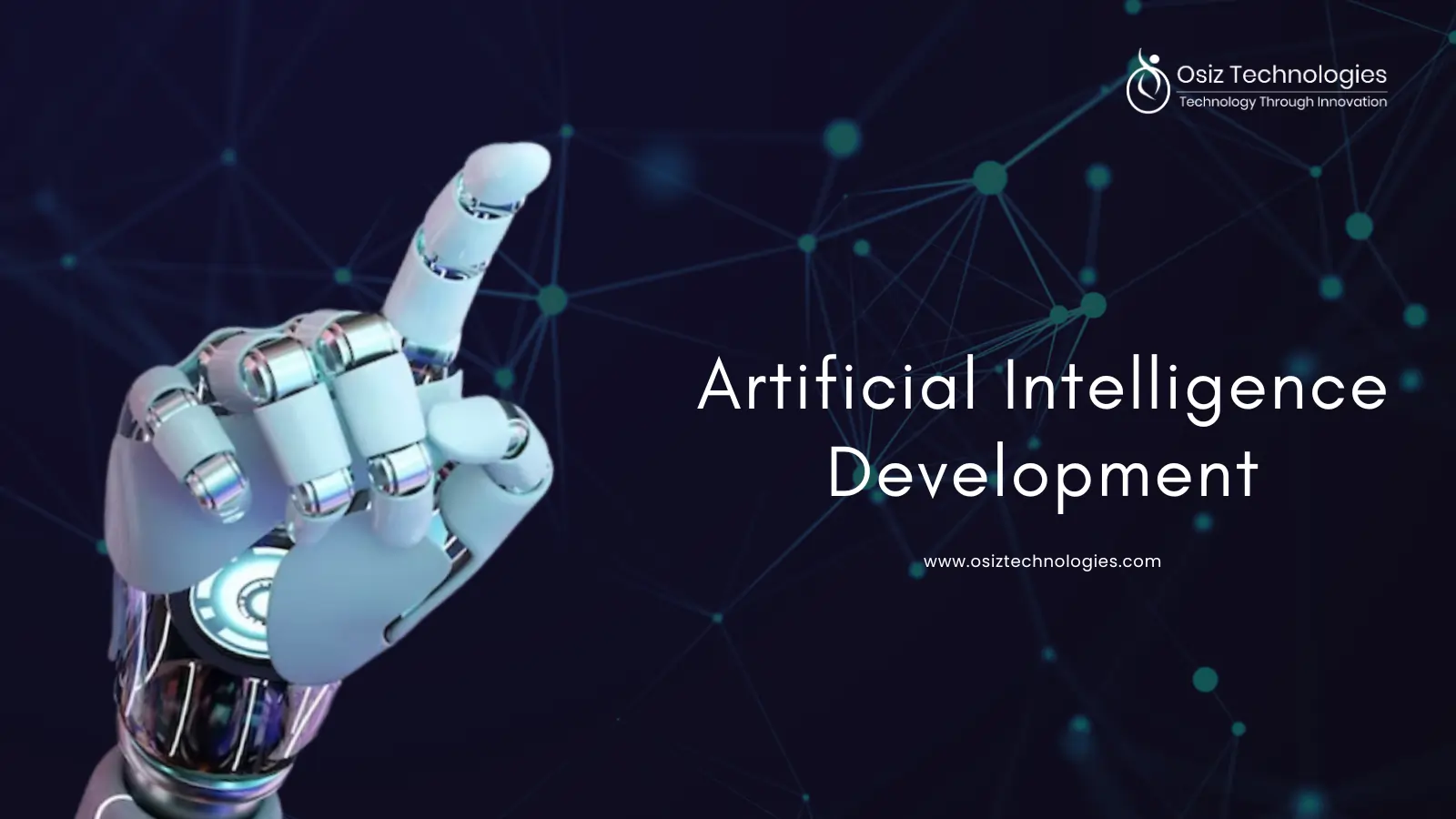Artificial Intelligence in Banking
Artificial intelligence is transforming traditional banking processes, improving customer experience and operational efficiency. Through advanced AI algorithms, the entire banking sector is experiencing an unparalleled transformation by automating repetitive tasks, delivering customized services, instantly identify fraudulent activity. From chatbots that answer customer questions to complex algorithms that predict financial decisions, banking sectors is poised towards the betterment with AI. Now, this blog will walk you through the various use cases of leveraging AI in banking.
Perks of AI in Banking
Improved Customer Experiences: AI-powered chatbots and virtual assistants provide individualized, 24/7 customer service, guaranteeing that clients get help when they need it, without regard to time limits.
Better Decision-Making: AI's real-time data analysis enables banks to make well-informed choices, maximizing credit risk assessments and investment plans. This decreases default risks, increases profitability, and creates new opportunities.
Enhanced Security: AI ensures that even the most committed fraudsters encounter strong obstacles while trying to get past the bank's defenses by constantly modifying encryption procedures in response to changing threats.
Decreased Cost: By leveraging AI, banks can interact with their consumers more effectively. Through this, the banks can lower their expenses related to bringing on new clients while simultaneously boosting consumer loyalty.
Automated Workflows: AI-powered automation makes it possible to streamline procedures and workflows, allowing for more independent and accountable operations as well as improved decision-making and service provision.
Use Cases of AI in Banking
Real-time Transaction Monitoring: AI algorithms perform fairly well in real-time pattern identification and anomaly detection. It is applied over transaction data to identify trends that could suggest fraud. For instance, a series of purchases from various geographies in quick succession might be a sign of a stolen credit card. Similarly, AI algorithms are constantly monitoring spending patterns. Quick identification of an unexpected and therefore hidden spike in spending or purchases in odd categories are identified and marked as red flag signs.
Investigating Consumer Behavior: It pools a lot of information from multiple sources like online activity, account statements, transaction logs, and client demographics. Then it presents an excellent view of each customer's financial profile by incorporating all of this data into a common database. AI is great at using complex algorithms to scan for patterns and trends. Some of these persistent habits include repeated online shopping, regular payments of bills, or regular savings. This is how AI learns the financial preferences and patterns of humans.
Automated Loan Approvals: The financial institution possesses a loan approval system. It employs AI to automatically process loans. The online loan application provided by the borrowers comprises all their details along with other necessary financial information. In return, the system is careful to be factually correct about its data acquired from various sources, for instance, income statements and credit reports. The system analyzes the creditworthiness of the potential applicant through the assistance of complicated algorithms and credit scoring models, based on factors such as debt-to-income ratio and credit history.
Automated Financial Report Generation: The use of AI in the generation of financial reports can be automated, thus allowing efficient filtering of large volumes of financial data coming from multiple sources; hence, it ensures speed in the generation of reports to a business. Companies that use AI with their financial services will manage to produce complete and error-free financial reports, retrieve relevant information, and verify the accuracy of data. Using AI accelerates the process by automatically providing data gathering, pertinent calculations, and the drawing up of reports while adhering to regulatory standards.
Explore Upselling And Cross-Selling: Through AI, it becomes possible for banks to identify what their customers lack or are currently missing, which in turn can help the bank identify upsell and cross-sell opportunities more precisely. With AI-fueled insights from CRM data, such banks can provide products and services that make all the difference to a customer's specific needs, which again helps them enhance the fulfillment levels of customers while boosting revenue streams. Such proactive identification helps banks deepen the relationship with a customer, pushes the adoption of other products as well, and sustains growth in a highly competitive market environment.
Sophisticated Document Processing: AI accurately derives any useful insights and information from a variety of financial documents, which include contracts, agreements, statements, and receipts. AI improves the efficiency, accuracy, and decision-making process of financial institutions when it comes to the automation of extraction, interpretation, and processing of information in these documents. It can help streamline the workflow, reduce errors, save labor, and extract important information from large volumes of financial data by making use of AI in document processing.
Automation of Credit Check: Banking and financial institutions can do something revolutionary in the name of credit checking with the help of AI algorithms for the same. Algorithms take in and process a vast amount of consumer data that may include credit histories, work histories, and financial statements, among others. They can quickly and accurately assess the amount of creditworthiness a customer has by processing this amount of data. This assessment enables an institution to make well-informed lending decisions within a fraction of the time by providing credit scores based on the data analysis.
Fraud Detection: For many years, the presence of banks has endured the devastating risk of fraud. Identity theft, credit card fraud, and money laundering are just a few examples of fraudulent activities that cost banks billions and billions of dollars annually. Banks and other financial institutions should be able to discover suspicious activity that prevents losses by using AI algorithms that can analyze large volumes of data in real time. A more sophisticated understanding of fraud patterns enables machine learning models to better and more efficiently recognize suspect activity.
Investment Portfolio Management: AI can also aid the management of investment portfolios since it can offer insights into performance and possible hazards. For instance, through AI, one can obtain knowledge of whether equities are overpriced or underperforming, and investors will have the choice to either sell or hold. AI can further suggest recommendations on asset allocation or portfolio rebalancing, which can help achieve investors' monetary goals. With market data analytics and inexpensive stocks or new trend detection, AI can identify investment opportunities.
Virtual Assistants and Chatbots: AI chatbots offer efficient first-line support with the assistance of resolving frequent client questions and problems. The human customer support officers can focus on more complex queries as they can easily generate account balance information, transaction history, and other account details. With the analysis of consumer data, such as history of transactions and spending behavior, it can answer nearly immediate customer queries and suggest personalized recommendations.
Automating Risk Management: With its ability to identify potential threats by analyzing data from numerous sources which may include news articles and financial reports, etc., AI can also automate risk management. For instance, reports from the news regarding a specific industry or enterprise can be analyzed to determine potential risks in the form of litigation or damage to the brand. Banks and other financial institutions may proactively identify and solve the problems related to compliance using the automation of risk management.
Analyzing Market Trends: The AI algorithm scans and analyzes the trends in the market to see if there is any trend in the area and generate insights. An example of AI could be the forecasting of subsequent trends based on observed patterns of stock price. It helps investors make the right decision regarding investment with maximum precision. Given the sea of data that is available today-from news stories to social media posts and financial reports-it is possible to understand what is actually moving in the market. This enables investors to reduce possible risks and change their investment plans appropriately.
Segmenting Customers: AI can help the banking industry segment its customers in deciding who is credit-worthy. An optimal incentive emerges for creditworthy persons in more creditworthy consumers being offered customized loan offers such as lower interest rates or higher loan amounts. Borrowers with lesser credit scores get loan terms that are more cautious and that indeed enhance risk management while aligning lending practices with personal financial goals.
Steps to Integrate AI in Banking
1. Specify Goals And Use Cases:
Clearly state the aims and purposes of incorporating AI into your financial and banking processes. Determine certain use cases, such as risk management, automated customer support, fraud detection, and customized financial services.
2. Gathering And Preparing Data:
Collect and prepare the relevant data from all the sources, that is transactional histories of the clients, the market data, and so on. In any case, the performance of AI models depends totally on the quality of input data hence ensure that the data collected turns out to be appropriate and of a good quality.
3. Technology Stack And Infrastructure:
Invest in a strong IT foundation that can manage workloads using AI. Select appropriate AI frameworks and technologies, such as data processing platforms, machine learning libraries, and natural language processing tools, based on the use cases that have been discovered.
4. Training And Developing AI Models:
Engage AI experts and data scientists to develop and train the machine learning models on selected use cases. Train with histories, and improve with continuous incremental updates as the data becomes available.
5. Integration With Current Systems:
Easily incorporate AI technologies into current financial and banking systems, such as transaction processing systems, CRM platforms, and core banking systems. Assure data flow and interoperability between traditional systems and AI components.
6. Validation And Testing:
Make sure AI models are rigorously tested in a controlled setting to confirm their accuracy and effectiveness. Test for a range of scenarios, including edge cases and unforeseen difficulties that might occur in everyday life.
Are you looking to integrate AI into your banking operations? Osiz, a leading AI development service provider, can help you achieve your goals with customized AI solutions. We guide you through identifying use cases, collecting quality data, and building robust models. Let us use cutting-edge AI technology to help you enhance your financial services!
Why Choose Osiz for AI in Banking Solutions?
Osiz is the most trustworthy and reputed AI development company that offers excellent AI solutions for the banking sector. The banking sector has seen incredible breakthroughs and opportunities as a result of integrating AI. The use of AI in banking has greatly improved decision-making, customer experiences, risk management, and operational efficiency. AI's role in fraud identification and prevention has also proven crucial in protecting consumers and banks from fraudulent activity. Looking ahead, artificial intelligence in banking has a bright future. AI technology's continuous development in conjunction with financial institutions' continued cooperation.
Listen To The Article
Recent Blogs

X-Mas 30%
Offer











